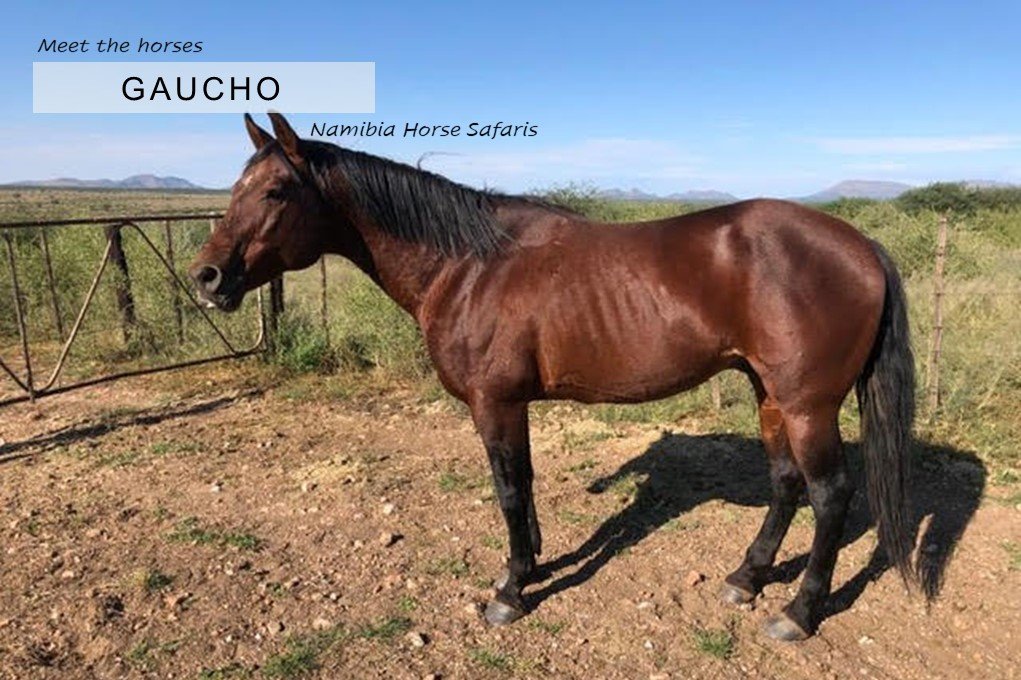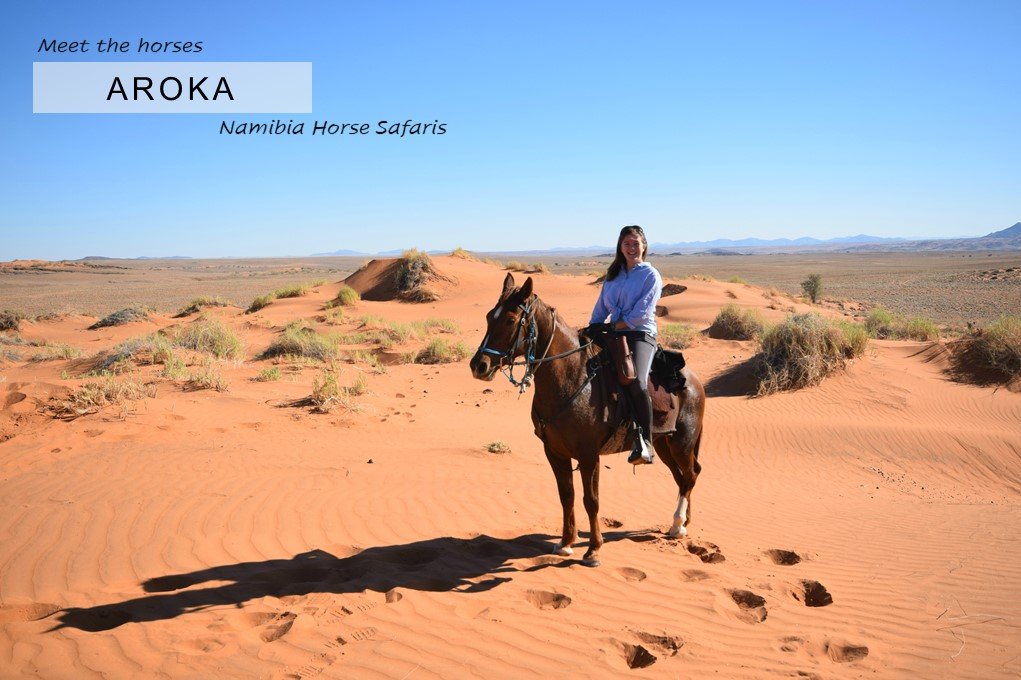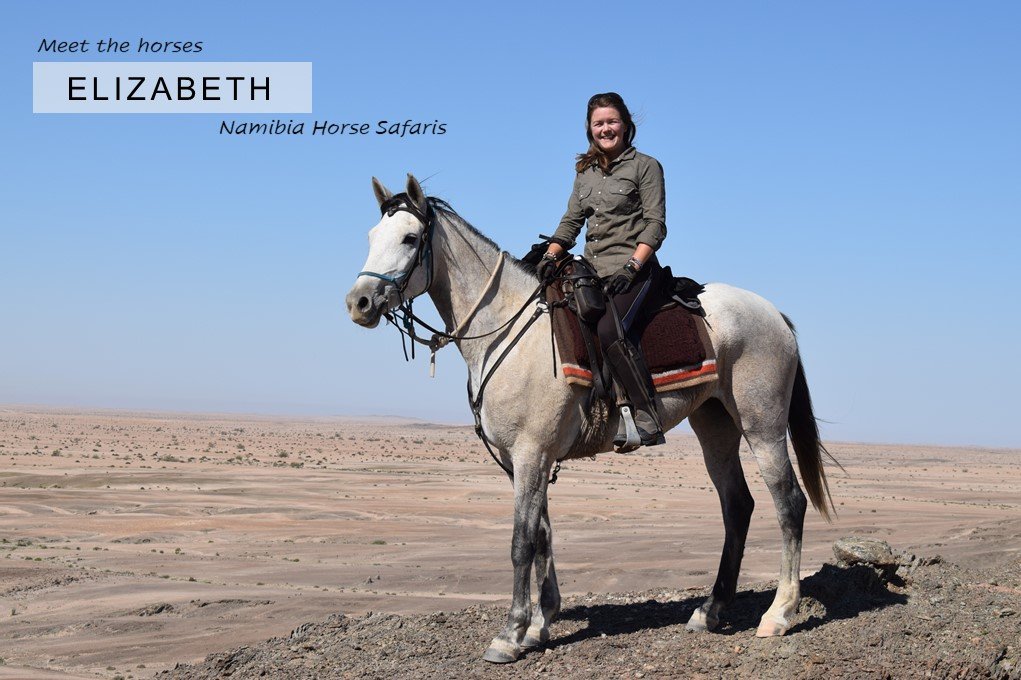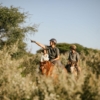We’re continuing the “Meet the Horses” series in Namibia. This region is not for the faint-hearted. Crisscrossing the Namibian landscape on horseback requires horses that are tough, brave, resilient, a strong mind and a healthy dash of attitude.
First, we’d like you to meet their legendary quarter horse stallion Gaucho and two of his offspring, Habanero and Muchacho (can you see the pattern?!) If you’ve experienced the thrill of a Namibian Desert Crossing on horseback in the past few years, chances are you would have met one of Gaucho’s progeny. Gaucho’s offspring provide all of this, by the bucketload. The team in Namibia have found that the Quarter horse / Arab cross works very well which gives the ‘cow sense of the Quarter Horse, and the zing of the Arab’. Gaucho is also matched with Warmblood, Boerperd and Hanoverian cross mares to produce his talented line.
GAUCHO

It started at Desert Homestead, where the neighbour acquired 6 new horses. These would intermittently jump the fence and chaos would ensue. One day, Andrew marched next door offering to buy the horses, and an offer of N$8000.00 (about USD600) was accepted for all 6 horses. Turns out the horses belonged to the previous manager who had moved on and left his horses behind. A few weeks later a chap came for a job interview, stating he owned horses in the Sossusvlei area – and it soon became apparent they were talking about the same horses! As possession is nine-tenths of the law, they remained with Andrew. Initially, he had no intention of breeding with the “stray stallion” and had asked the vet to castrate him, much to the previous owner’s horror!
As it so happened, for the best for Gaucho and the team, only one of his testicles had descended making it a much more complex operation than originally thought and the vet returned from Desert Homestead without his trophy. It was during this reprieve that they learned of Gauchos heritage and he was duly appointed “sire of trails horses”. Many of our guests will know Habanero, Muchacho, Cuervo, Kariba, Hombre, Macarena with Pablo, Molly, Hemisphere and Halo about to make their debut onto the safari scene.
Right now, Guacho is enjoying his lockdown with three mares at the base near Windhoek. Andrew has put him with sisters Polka and Schnute (the two chestnut Warmblood cross sisters, much loved by guests on the trail) and Kayla, a bay Thoroughbred cross.
MUCHACHO & HABANERO
Muchacho and Habanero are called The Kalahari Bro’s as they were born and grew up together on a farm where there is generally grass, even when the rest of the country is suffering drought. They both started together in 2017, on the same safari.
Habanero is 15.1 hands and a cool character. He can be ridden by anyone, especially if his chum Muchacho is around – he’s even sometimes ridden in a neck strap by confident riders. He has a very curious lip-smacking habit when drinking – which gets everyone laughing – and curiously his half-brother Haegar does the same thing….
Muchacho has a calm relaxed demeanor with a very merry, high stepping action in the trot and canter which is extremely comfortable to ride. He is best suited to confident riders as he can be timid at times but is growing into his confidence as he matures. He is much loved by anyone who is lucky enough to be paired with him on an epic adventure across the hauntingly beautiful landscapes of Namibia. Muchacho is relatively new to the working crew as he was started as a three-year-old by Phoebe on the farm Seeis from December 2016. Phoebe’s gentle and patient guidance produces calm, reliable horses that are sensitive to light aides. Muchacho joined his first safari as a loose horse to get used to safari life, but also occasionally ridden by Phoebe as back up rider. They had a chance encounter with a lion (which is rare in Namibia), but level headed Muchacho handled it like a pro. He has since got several safaris under his belt… or girth 🙂
🐴 Name: Muchacho
🐴 Height: 15.3hh
🐴 Breed: Quarter Horse x Arab
🐴 Gender: Gelding
🐴 Age: about 6
🐴 Colour: Dapple Grey
🐴 Personality: Calm and relaxed
🐴 Quirk: Can be as timid as a mouse or as brave as a lion depending on the rider
🐴 Suitable for: Confident but gentle rider
🐴 Best trait: Has a way of making everyone fall in love with him
🐴 Worst Trait: can be hesitant at times
AROKA – THE POCKET ROCKET
Aroka is from the Cherubim stud, in Namibia, which has registered Nooitgedachters, Arabs and Quarter horses, all bred for their endurance in the extreme Namibian environment. While she might not have the conformation of a typical endurance horse, she has been part of the herd for 9 years and has proven to be a true champion! Despite her size, she would easily come in the top 3 fastest horses of the full Namibia herd. She is incredibly fast out the blocks, often climbing from the back to the lead in any race across the desert. Isabel was lucky enough to ride her and said that when she gets going in that fifth gear, you feel like your feet are almost brushing the floor as she reaches flat-out for each stride. Like clinging on to a low-flying, eye wateringly fast cocktail stick! Aroka is wonderfully responsive and can even be ridden in a halter. She is a feisty little mare and hangs out with her elite circle, Lavida, Flica, Macarena. Mares seem to be very opinionated and only like those they hang out with – the exclusive club! The geldings know to keep their distance! She is very intelligent and hard-headed and needs a skilled rider as she will scurry out from under you if you don’t have the skill to stay on
🐴 Name: Aroka
🐴 Height: 14.3hh
🐴 Breed: Quarter Horse x Arab
🐴 Gender: Mare
🐴 Age: about 16
🐴 Colour: Chestnut
🐴 Personality: Does not like people, very difficult to catch this little madam
🐴 Quirk: Not easy to ride – so quick and nippy that she can maneuver out under people, but one of the fastest horses in the herd and she loves to fly!
🐴 Suitable for: Intermediate to advanced rider
🐴 Best trait: Speedy! No horse can catch this one – a real quarter horse over a short distance
🐴 Worst Trait: Try and catch her! So Cow-hocked that she pinched her own tail between her hocks
ELIZABETH
Elizabeth was bred to herd cattle and started her life roaming the vast farmlands as a semi-wild horse. Living out as a herd and rarely seeing people, she came became a trail horse in 2015 and found her calling. Many of the horses in Namibia are related and it is thought that Sundown and Four-socks might be half-siblings, but it is difficult to tell as they were free-roaming and hardly seen by humans for about 6 years. Liz was part of the herd when Karien rode in Namibia, she was loose most of the way and enjoyed causing havoc on every gallop – relishing in cutting up the other horses and riders! You would see her grey shape motoring towards you out of the corner of your eye, waiting for her to slice in front of you, only just leaving enough room. So much so, shouting ‘Elizabeth MOVEEEE’ is still one of their inside jokes. Needless to say Liz would often then be punished by having her loose-horse freedom taken away and getting put back on the lead reign by Andrew! Last year while on the trail, she ate something poisonous and the team was just able to pull her through – trucking her from camp to camp. She has traded her safari life for retirement back out on the farm where she has the cutest rider imaginable who is as light as a feather and loves grooming her. Baladine, her sweetheart has joined her for a pampered life on the farm, happily together as these two are inseparable. As the new safari horses come into the herd, these to deserve a life of luxury.
🐴 Name: Elizabeth (Liz)
🐴 Height: 15hh
🐴 Breed: Pure Namibian Farm Horse
🐴 Gender: Mare
🐴 Age: about 9
🐴 Colour: Dapple grey, but becoming lighter with age
🐴 Personality: Does not like people, very difficult to catch this little madam
🐴 Quirk: Very dependable + co-operative riding horse, yet not crazy about people.
🐴 Suitable for: everyone, dependable to a T
🐴 Best trait: Enjoyed being on trail
🐴 Worst Trait: Weak back and caused chaos on trial as a loose horse
JIM
Jim was acquired from the monthly farmers market at the Showgrounds in Windhoek. Andrew went to get a pancake and came back with a horse! Jim wasn’t ideally suited to his job giving pony rides at the market because he didn’t like kids and demonstrated this by biting them. He had a brief chat to the owner who was mildly distressed and promptly swapped Jim for one of his more suitable safari retirees (win win!) Jim certainly has strong views on many things in life. The first time he was made a loose horse on safari, he promptly ran away. As to not have a repeat performance, he now has to be led when not under saddle, most often by his buddy Cantura. Jim however leads the leader now… at his pace! Besides his quirks, Jim is surefooted, brave and confident. He is very good at forging a way through impenetrable, lion infested reeds.
LARRY
His registered name is Arc de Cour, and he is from a very aristocratic Warmblood line…. his sire the well known Belgian Warmblood De La Coure. Arc de Cour was sold into the show jumping world in South Africa but his antics got him the nickname: “Widow-maker”. No one could stay on the bronco. So back he came to his home (Seeis stud)…for ‘fixing’. It so happened he arrived home just as the 2019 Wild Horses Safari was going out – so along he came for the ride. Renamed Larry, Andrew decided the only way to help him would be to put him in a safari string – it has helped many a horse before. So off Larry went with 18 other horses on our truck (at 16,2 he could only just fit) – down to Wolwedans in the southern Namib, a long and dusty journey. Larry seemed somewhat bemused to find himself in a desert – standing on the picket line, looking around and no doubt wondering how he got here, and what this ‘here’ was. But he did what the other horses did and seemed to be ok. From day 1 (as a loose horse at first) Larry seemed to think this was a good way to spend a day – moving from place to place, being given a large quantity of food several times a day, being groomed and occasionally being ridden. It is a testament to Andrew’s horsemanship and the companionship of being part of “doing a job” that he has now become Andrew’s favourite lead horse. (The late great Ray Hunt and Tom Dorrance said this was the most important way to help a horse – give him a job.
A FEW OTHER FAVOURITES
HOW THE SAFARI HORSES ARE CARED FOR
Between safaris, the horses stay relatively fit by living out in thousands of hectare of natural bush. During the good times, the whole 100-strong herd lives together, but during droughts they are split into groups of 20 and sent to farms where there is still grass. The herds form natural social bonds and because they are more comfortable within these familiar groups, they go on safari together too. They do a 10-night safari every six weeks or so between April and late October remaining fit between safaris by walking huge distances from grazing to water every day. All the horses spend the four/five months of our Namibian summer out in the bush roaming free.
While on safari horses are continually fed – even at night and are groomed three times a day. Backs, legs, feet etc. are regularly checked and each horse has a mini-vetting at the end of the day to ensure they are fit for work the next day. Because injuries do occur, and young horses need more rest than experienced campaigners, we have several spare horses on safari which can be rotated. This is a tense time for those guests who, having fallen in love with their horse, wait in anticipation of their mount being given the green light to work the next day.
WHAT TACK THEY USE
They use simple snaffle bridles or bit-less bridles where possible and each horse has its allotted bridle and specially designed saddle for the duration of the safari, which are cleaned daily. The Namibian team is lucky to have an expert saddle-maker on hand who has designed the new safari saddles specifically for the purpose. They spread the rider’s weight evenly over a wide area yet leave the shoulder free to move naturally. Stirrups have been placed specifically to allow riders to stand and so ease the horses’ backs at regular intervals. Water panniers have been moved to the back of the saddle to not restrict the riders’ knees. Wool and Mohair girths allow for maximum comfort and numnahs are a combination of pure wool pads and specially folded blankets. There are all hand-washed without the use of chemical soap after each safari.
AFRICA IS CALLING – WILL YOU BE BRAVE ENOUGH TO CROSS THE DESERT?






















